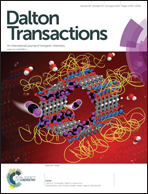Protonation effect on ligands in EuL: a luminescent switcher for fast naked-eye detection of HCl†
Abstract
A new luminescent coordination polymer, EuH(L)2(NO3)2 (EuL, HL = 2-(2-pyridin-2-yl)quinoline-4-carboxylic acid), has been solvothermally synthesized, and its framework of uncoordinated pyridyl rings was exploited for the binding and specific sensing of HCl via a protonation effect. The protonation effect changes the energy of the excited state of the ligands, rendering them unable to act as efficient antennae for Eu3+ characteristic emission. Thus, we have developed a new, fast and convenient sensor for HCl, a gas harmful for the environment.


 Please wait while we load your content...
Please wait while we load your content...